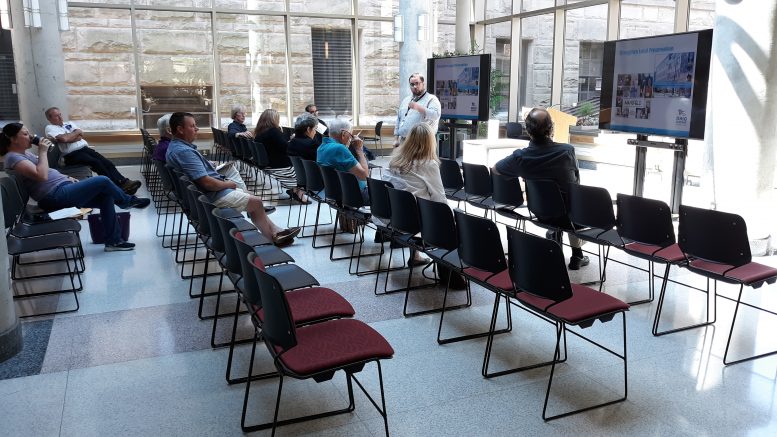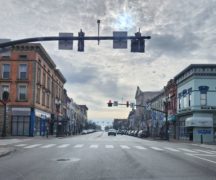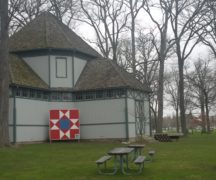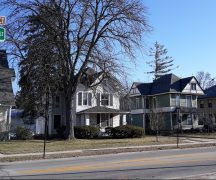By JAN LARSON McLAUGHLIN
BG Independent News
“Ugly” doesn’t cut it when historic preservation decisions are made. Bricking up old ornate windows may turn the stomachs of those who appreciate historic architecture – but saving old structures requires specific rules if actions are going to stand up in court.
Being a “monstrosity” is not a legal term, Nathan Bevil, from the Ohio Historic Preservation Office, explained recently to members of the new Bowling Green Historic Preservation Commission.
“‘I don’t like it’ and ‘That’s ugly’ are not legally defensible decisions,” Bevil said. “That might be what you’re thinking. But ‘ugly’ does not count in court.”
Bevil met recently with city officials, including the members of the newly formed Historic Preservation Commission. The commission members are Les Barber representing the First Ward, Reina Calderon of the Second Ward, Gail Nader of the Third Ward, John Sampen of the Fourth Ward, and commission president Greg Halamay representing the downtown.
Though a young nation in comparison to much of the world, Americans have worked to preserve its historic structures. That effort began in 1853, when official steps were taken to save George Washington’s home.
“The preservation impulse has been very strong in the U.S.,” Bevil said.
The National Historic Preservation Act of 1966 helps protect historic buildings, landmarks and districts.
“It became a fight against urban renewal and demolitions,” he said.
In Ohio, efforts to save the German Village area of Columbus began in 1960 – but only after about half of the area was demolished for a highway, Bevil said.
Many municipalities in Ohio have historic preservation commissions in place. Seventy-four communities already have Certified Local Governments in place to better protect historic structures. They range in size from Zoar, with a population of about 175, to as large as Cleveland. Several college communities – like Athens, Kent and Oxford – have such certifications in place, Bevil said.
Cities like Toledo, Akron and Tiffin are taking advantage of preservation tax credits to rebuild central city business districts and enhance property values in historic neighborhoods.
Bevil described the benefits of Bowling Green becoming certified.
“These cities made a commitment,” and have funding and public education available to them, he said.
The design review process of historic preservation commissions guide development, Bevil explained. The goal is not to prevent new business or growth.
“It’s making sure whatever change happens, respects that historic character,” he said.
The commission must make “legally defensible decisions” that are somewhat flexible, Bevil said. And it cannot take any action on development or changes that have already occurred.
“It’s guiding whatever is going forward,” he said.
By going through the certification process, Bowling Green will have access to state funding to help with training and operations for historic preservation.
The city resurrected its plans to preserve historic structures in the community last year. The commission will work to debunk myths about historic preservation rules that doomed the first effort about five years ago. Mayor Dick Edwards reintroduced plans for a commission last year to “preserve, promote, encourage and support the maintenance, use and reuse of historic buildings in the city.” In other words, it would help property owners who want to preserve historic structures.
Some historic homes are losing the battle against time and rental transformation – such as in the area surrounding the Wood County Courthouse, Edwards said.
“It’s very painful to watch some of these very beautiful historic homes becoming rental homes,” the mayor said.
The proposal for such a commission was first brought up in 2009, then became part of earnest discussions in 2013. Efforts died in 2015 after some citizens interpreted the city’s preservation efforts as government telling them what to do with their properties.
At that time, Edwards tried to explain that the commission was there to help – not give orders. Nevertheless, suspicions and very vocal objections by a few citizens about the motivation for the historic preservation commission killed the effort.
City Planning Director Heather Sayler said there is great value in preserving historic buildings in a community.
This time around, the city and the commission members hope to do a better job of educating the public and calming fears.
The goal of historic preservation is to protect the historic integrity of buildings – and help when possible with restorations. It is not to nitpick and tell homeowners what they can and cannot do with their properties.





